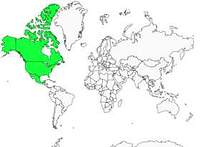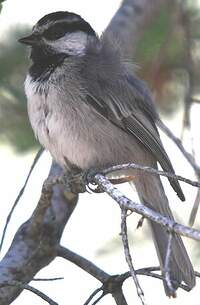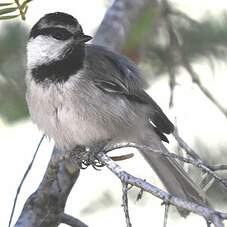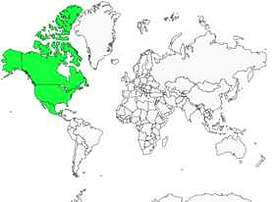Mountain Chickadee
Poecile gambeli - Mésange de Gambel
Identification
The Mountain Chickadee is a discreetly plumaged bird, black, white and grey. It is recognized by the pattern on its head: the black crown and mask are separated by a white eyebrow, which gives it a severe look. The white eyebrow is thicker in the nominate subspecies. The eyebrows join the white forehead. The cheeks are pale, almost white. The wide black bib extends in a triangle to the chest. The back, wings and tail are grey, slightly shaded with olive or brown. The underside is light grey, with a beige shade on the flanks in the nominate subspecies (which lives in the Rocky Mountains). The tiny beak is black, the legs are grey and the iris is dark brown. There is no sexual dimorphism. The male is just slightly larger. The juvenile looks like the adult. The Mountain Chickadee's white eyebrow allows it to be distinguished from the Black-capped Chickadee and Brown-backed Chickadee, two species that share part of its range. The lack of crest allows it to be distinguished from the Eurasian Blue Tit, also present in the same regions. Despite its white eyebrow, the Mountain Chickadee is genetically very close to the Black-capped Chickadee, with which it can hybridize, especially when the environment is degraded.
Subspecific information 4 subspecies
- Poecile gambeli gambeli (e Rocky Mts. in wc USA)
- Poecile gambeli baileyae (Pacific slope of the Rocky Mts. in w USA and w Canada)
- Poecile gambeli inyoensis (central Rocky Mts. in w USA)
- Poecile gambeli atratus (nw Mexico)
Foreign names
- Mésange de Gambel,
- Carbonero montañés,
- chapim-da-montanha,
- Gebirgsmeise,
- Gambel-cinege,
- Gambels Mees,
- Cincia montana,
- bergtita,
- Bergmeis,
- sýkorka Gambelova,
- sýkora horská,
- Bjergmejse,
- vuoritiainen,
- mallerenga de muntanya,
- sikora górska,
- kalnu zīlīte,
- Гаичка Гамбела,
- マミジロコガラ,
- 北美白眉山雀,
- bergtita,
- 高山山雀,
Voice song and call
The Mountain Chickadee is vocalized typically as a Poecile. Its song is quite similar to that of the Black-capped Chickadee. It is a series of 3 or 4 notes on two tones, see tu tu, see tu tu, see see tu tu, with some variants, all pleasant to the ear. The call is a monotonous succession of notes somewhat nasal like tsiu tu tu, tsi tiu tein tein tein,see tee tu tu tu,pi sit hein hein hein,tsi i i i tin tin and variants. In addition there are numerous short and sharp cries typically chickadee.
Habitat
The Mountain Chickadee frequents mountains forests populated by conifers (pine, spruce, fir, Douglas), as well as aspen groves growing among the conifers, and mixed pine-oak or juniper-pine forests.
Behaviour character trait
The Mountain Chickadee is generally sedentary, but it may wander to low altitudes during the winter, taking advantage of conifer plantations.
Wandering individuals are mostly yearlings. Movements are more significant in years with poor conifer fruiting. It is one of the most common birds in the coniferous forests of the mountainous areas of its range. However, it is not always easy to observe, as it often feeds in the highest parts of the trees. In winter, Mountain Chickadees join mixed flocks of birds, like our European tits. It is a gregarious bird which lives in social, territorial and hierarchically structured groups. The Mountain Chickadee hides conifer seeds, especially in autumn. Surveillance of caches is made easier by living in sedentary social groups. Yearlings who go to low altitudes in winter return to their social group in the spring. Pairs are usually formed within the group.Flight
Dietfeeding habits
The Mountain Chickadee primarily consumes insects (caterpillars, beetles, aphids, scale insects, eggs and larvae of various kinds of insect), spiders and their eggs, seeds (especially from conifers) and berries.
It feeds high up in the trees (mainly in the conifers), and looks for its food on the foliage, on the end of the branches, often head down. It also searches for cracks in the bark of trunks and larger branches. A documented possible use of a piece of wood to search for prey in a deep crack has been reported. It sometimes catches insects in flight. In autumn, it stores conifer seeds, which allows it to survive the winter without migrating. It visits bird feeders.Reproduction nesting
The Mountain Chickadee is monogamous and territorial. It nests in a cavity like other chickadees (natural cavity, former woodpecker hole, nest box).
The cavity used is generally at a height between 1.5 m and 8 m. The nest is sometimes built in a stump very close to the ground, especially in areas where trees have been cut down. The same cavity can be used several years in a row. It is lined with soft materials (bark fibers, grasses, moss, hairs and feathers) by the female. Once the nest is comfortable enough, the female usually lays 7 to 9 eggs (sometimes 5 to 12). These are white, often spotted with reddish-brown dots. Incubation is probably done solely by the female, for about 14 days. The adult disturbed at the nest climbs to the entrance of the cavity emitting a hiss like that of a snake. The days following hatching, the female protects the young in the nest, while the male goes to look for food (mainly insects). Then the two parents feed the young, who remain in the nest for about 3 weeks. Laying occurs between May and July. There is usually only one brood per year, unless the first brood fails. There is often competition for nesting sites with other cavity-dwelling birds (Pygmy Nuthatch, Bluetail, White-faced Swallow, European Robin...).Geographic range
The Mountain Chickadee is found in the western parts of North America, including the Rocky Mountains. Their range stretches from southern Alaska and the Yukon (Canada) to Lower California (Mexico), passing through British Columbia and Alberta (Canada), and all the western states of the US: Washington and Oregon in the west to Montana, Wyoming, Colorado and New Mexico in the east, going through Idaho, Utah and Nevada. Some individuals have been known to stray out towards the Great Plains east of the Rockies during winter, but these occurrences are rarely observed.
Threats - protection
IUCN conservation status
concern
in the Wild
threatened
evaluated
The Mountain Chickadee is widely distributed and common. However, studies show a decline in some regions. The population of Mountain Chickadees in a given area can be limited by the lack of cavities. Forest management impacts the availability of food and nesting sites. This can be partially offset by the installation of birdhouses and feeders, but reasoned management of forests is still preferable for the good health of the species and all other species living in these environments.
Sources of information
- IOC World Bird List (v15.1), Gill, F and D Donsker (Eds). 2025-12-07.
- American Birding Association Field Guide to Birds of California, Alvaro Jaramillo
- Field Guide to the Birds of Western North America, Jon L. Dunn and Jonathan Alderfer
- Audubon,
- Birds of the World, The Cornell Lab of Ornithology
- BirdLife International, BirdLife International
Other sources of interest
 Specification sheet created on
13/07/2023 by Régine Le Courtois Nivart
Specification sheet created on
13/07/2023 by Régine Le Courtois NivartTranslation by AI Oiseaux.net
© 1996-2025 Oiseaux.net
- Accipitriformes
- Aegotheliformes
- Anseriformes
- Apodiformes
- Apterygiformes
- Bucerotiformes
- Caprimulgiformes
- Cariamiformes
- Casuariiformes
- Charadriiformes
- Ciconiiformes
- Coliiformes
- Columbiformes
- Coraciiformes
- Cuculiformes
- Eurypygiformes
- Falconiformes
- Galliformes
- Gaviiformes
- Gruiformes
- Leptosomiformes
- Mesitornithiformes
- Musophagiformes
- Nyctibiiformes
- Opisthocomiformes
- Otidiformes
- Passeriformes
- Pelecaniformes
- Phaethontiformes
- Phoenicopteriformes
- Piciformes
- Podargiformes
- Podicipediformes
- Procellariiformes
- Psittaciformes
- Pterocliformes
- Rheiformes
- Sphenisciformes
- Steatornithiformes
- Strigiformes
- Struthioniformes
- Suliformes
- Tinamiformes
- Trogoniformes





















